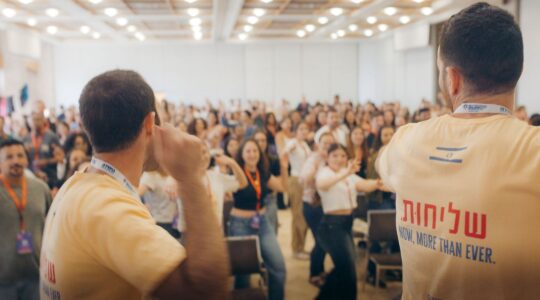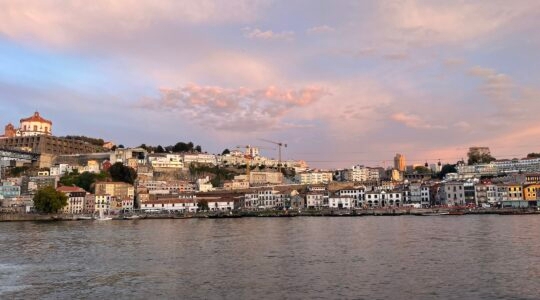(JTA) — In the summer of 2010, with just hours to go before campers arrived for the first day of the first season of Eden Village Camp, director Yoni Stadlin got some bad news from the health department: A procedural issue had delayed the issuance of a permit and the camp could not open as scheduled.
Luckily, another camp near the Jewish environmental camp’s Putnam Valley, New York, home offered a temporary space, but staff members were still forced to scramble. One put on a Moses costume and declared that, just as Jews took a circuitous route on their journey to the Promised Land from Egypt, Eden Village campers would take the long road to their summertime home. Daily programming was improvised on the fly. Supplies were whatever could be rustled up. Programs were held in a field or the forest.
“It was the most pared down camp you can imagine,” Stadlin told JTA.
But it also taught him a crucial lesson.
“We had no amenities, no programming. We didn’t have the things we planned, all our gear,” Stadlin said. “Meanwhile our kids were blissing out. I was in crisis mode myself. But I walked outside my office, and my kids would be laughing. It was pure joy. It was pure camp.”
At a time when many Jewish summer camps are spending millions to build everything from gymnasiums to trapezes to science labs, a handful of Jewish summer camps have eschewed the pricey bells and whistles, focusing instead on the traditional homespun pleasures of, well, camp. Some have passed on fancy upgrades as a matter of principle, or because they don’t comport with the camp’s particular emphasis.
For others, it’s simply not their thing.
“It’s just not our style,” said Cindy Zingher, the executive director of the nonprofit Camp Kinderland, a social justice-focused camp in Tolland, Massachusetts, founded in 1923 by Jewish labor activists.
Kinderland, which serves about 250 campers in a season, has no tennis courts or swimming pool. Its performance center is named for the famed African-American singer and civil rights activist Paul Robeson and its bunks for Harriet Tubman and Anne Frank, among others. The camp has a lake for swimming and boating, basketball courts, sports fields and an arts studio. But Zingher told JTA that while Kinderland has invested in all the necessary upkeep and maintenance, it has no interest in fancy upgrades.
Neither does Camp Galil, a “kibbutz-style” Zionist summer camp outside Philadelphia founded in 1946. Galil just completed an exhaustive master plan that calls for the replacement or upgrade of nearly all its buildings over the next decade. But director David Weiss said the camp has declined to invest in significant new programmatic offerings because it wouldn’t fit with its focus on youth empowerment.
All the programming at Camp Galil is designed and executed by the counselors, who are generally in their late teens or early 20s, and changes significantly from year to year, depending on their interests. Weiss said that sinking significant sums into niche activities that may not be of interest to a shifting group of camp leaders doesn’t make sense for Galil.
“Our facility has to serve the camp philosophy,” he said. “So we require a greater deal of flexibility that other camps may not.”
Perhaps the most rustic Jewish summer camp in the country is Camp Ramah in the Rockies, located seven miles from the nearest paved road and an hour from the nearest store. Nearly 500 campers live in tent cabins with no electricity and relieve themselves in compost toilets. If they feel like a swim, the only options are icy mountain streams.
“I think parents that send their kids to our camp are really looking for kids to have an experience that is different from what they are growing up in,” said Eliav Bock, the camp’s director. “Many of our families are looking for a return to nature, a way to escape all of those things that we take for granted in built-up urban areas. And that’s why they send them to Ramah in the Rockies, for that rustic challenge.”
Camp directors who have gone with high-priced improvements say they are critical for camps to remain competitive in the marketplace. But Zingher says enrollment at Kinderland hasn’t been impacted by their investment decisions. The July session is full, and Zingher says the camp has brought in 40 to 50 new campers in the past three years.
“No one has ever come to us with any questions or thoughts about how we are in terms of the facility,” she said. “We’re not impressing in that way. We want people to come to us because they believe in the values. We’re a social justice camp.”
Talk of camping values is a common thread among camp directors whose institutions have largely declined to spend big on luxe improvements.
The bunks at Camp Tawonga, which was founded in 1925 on the edge of Yosemite National Park in northern California, have no electricity. When bunks need replacement, they are built from lumber the camp mills itself. The swimming pool hasn’t had a major upgrade since the 1980s.
“I know that our priorities are on preservation and restoration, not on new and fancy,” said Jamie Simon, Tawonga’s executive director. “It’s much more on the kids bonding and creating communities.”
“It’s all about relationships, not about bells and whistles,” Stadlin echoes. “It’s about what happens between people. And you can’t buy that.”
Of course, even camps that have spent big insist that friendship and community are ultimately what draws campers back each year.
At Surprise Lake Camp in upstate New York, the idea of building a million-dollar pool prompted some serious pushback from board members who feared it would diminish the camp’s namesake swimming spot. And though the pool was built last year — joining a gymnasium and ropes course among the camp’s offerings — director Bradley Solmsen says fancy upgrades are not what the camp experience is about.
“The program is the people,” Solmsen said. “The swimming pool for us is going to only get you so far.”
For camps that remain resolutely rustic, the values question often goes beyond the general emphasis on friendship and community. For example, at Eden Village, the camp set up an apothecary where campers make salves and tinctures from medicinal herbs grown on site. The culinary arts program — another common focus of investment at some camps — is built around produce grown at the camp’s two-acre organic farm.
“I think something that our camp is doing is merging ideas of fun and meaningful,” Stadlin said. “A lot of places, they’re in silos: Friday night we have our meaningful time, on Sunday we have our fun. All throughout our program, we’re doing that every day in a bunch of different ways.”
(This article was made possible with funding by the Foundation for Jewish Camp. The story was produced independently and at the sole discretion of JTA’s editorial team.)
RELATED:
Camp becomes the endless summer — thanks to social and smartphones
Here’s how summer camps welcome their youngest charges
In this family, all four siblings found spouses at the same summer camp






